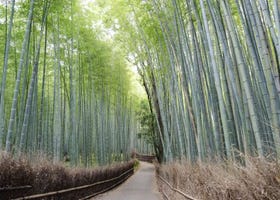Description
Tenryu-ji Temple was built in 1339 under the directions of Takauji Ashikaga in honor of Emperor Go-Daigo, who had just passed away. It is the top-ranking temple among the major Zen Temples of Kyoto known as the Gozan (Tenryu-ji, Nanzen-ji, Shokoku-ji, Kennin-ji, Tofuku-ji, and Manju-ji). The strolling pond garden, Sogenchi Teien (Sogen Pond Garden), was designed by Muso Kokushi (also known as Muso Soseki), who was the first head priest of the temple. It was the first garden in Japan to be designated as a Historic Site and Special Place of Scenic Beauty. Visitors can enjoy beautiful views throughout the seasons, including cherry blossoms in spring, changing leaf colors in fall, and snowscapes in winter, all against the backdrop of Arashiyama. Since it was constructed, the temple has been victim to eight fires, and the structures seen today were rebuilt during the Meiji Period. It was designated as a World Heritage Site by UNESCO in 1994 as one of the Historic Monuments of Ancient Kyoto.
・The Cloud Dragon Painting on the ceiling of Hatto Dharma Hall appears to be staring straight at visitors wherever they are standing
Hatto Dharma Hall was destroyed by fire in 1864 during the Kinmon Incident, and the Ungo-an Zendo (Senbutsujo) meditation hall, built in the late Edo Period, was relocated during the Meiji Period. The temple's principal image, Shakyamuni Buddha and his two chief bodhisattva disciples, are enshrined within the Hatto, which is one of the buildings that make up the Shichido Garan (ideal layout of a Zen Buddhist temple compound). A Cloud Dragon Painting was drawn on the ceiling by Meiji artist Shonen Suzuki, but this was replaced in 1997 with the current Cloud Dragon Painting drawn in the happo nirami style, which means the dragon appears to be staring straight at the viewers no matter where they are standing. The new painting was created by Matazo Kayama as part of large-scale renovations conducted on the 650th death anniversary of Tenryu-ji's founder, Muso Kokushi.
・A painting of Bodhidharma, founder of Zen Buddhism, can be found inside the Kuri (Temple Living Quarters)
The Kuri was built in 1899 and is one of the Shichido Garan structures. It was designed to act as a kitchen and temple office. In the entrance hall is a large screen with a painting of Bodhidharma, created by the previous chief abbot of Tenryu-ji Temple, Seiko Hirata. The painting has now become a symbol of the temple.
・While enjoying the view of the garden, sit down for Shojin Ryori (vegetarian meal) that was awarded Bib Gourmand status in ”MICHELIN GUIDE Kyoto Osaka + Tottori 2019”
Within the temple precinct is a restaurant called ”Shigetsu” where visitors can enjoy Shojin Ryori. This traditional Buddhist meal does not use any animal-derived ingredients and offers dishes that use various vegetarian ingredients depending on the season. Enjoy the view of the garden and try the Shojin Ryori that was awarded the Bib Gourmand status in ”MICHELIN GUIDE Kyoto Osaka + Tottori 2019.” Reservations required.
Location Information
-
- Address
-
68, Sagatenryujisusukinobabacho, Ukyo-ku, Kyoto-shi, Kyoto, 616-8385
-
- Nearest Station
-
Arashiyama Station
・ Keifuku Dentetsu-arashiyama Line
-
- Phone Number
-
075-881-1235Available languagesonly in Japanese
-
- Hours
-
8:30am - 5:30pm
*The north gate: open 9:00 am to 5:00 pm
8:30am - 5:00pm
*From 10/21 to 3/20*The north gate: open 9:00 am to 4:30 pm
-
- Closed
- None
-
- Public Site
- Official Site
Recommended Spots in Area
- Visiting
- Eating
- Shopping
- Lodgings
-
 Arashiyama Monkey ParkArashiyama, UzumasaZoos, Aquariums & Botanical Gardens
Arashiyama Monkey ParkArashiyama, UzumasaZoos, Aquariums & Botanical Gardens -
 SHOGUN STUDIO JAPANArashiyama, UzumasaOther Entertainment
SHOGUN STUDIO JAPANArashiyama, UzumasaOther Entertainment -
 RakushishaArashiyama, UzumasaOther Historic Sites
RakushishaArashiyama, UzumasaOther Historic Sites -
 Arashiyama Cherry BlossomsArashiyama, UzumasaSpring
Arashiyama Cherry BlossomsArashiyama, UzumasaSpring -
 Chikurin-no-Michi (bamboo forest)Arashiyama, UzumasaOther Nature
Chikurin-no-Michi (bamboo forest)Arashiyama, UzumasaOther Nature -
 Tenryu-ji TempleArashiyama, UzumasaTemples
Tenryu-ji TempleArashiyama, UzumasaTemples
-
Sun Members Kyoto SagaArashiyama, UzumasaHotels
-
Yado ArashiyamaArashiyama, UzumasaEconomy Hotels
-
TsubameyaArashiyama, UzumasaJapanese Guest Houses (Minshuku)
-
The GrandWest ArashiyamaArashiyama, UzumasaHotels
-
Ryotei RangetsuArashiyama, UzumasaRyokan
-
Guesthouse AtagoyaArashiyama, UzumasaJapanese Guest Houses (Minshuku)






































